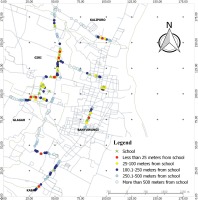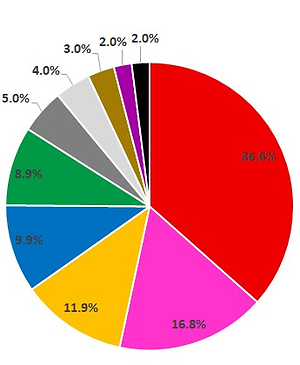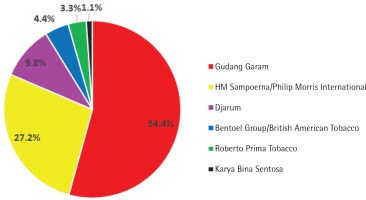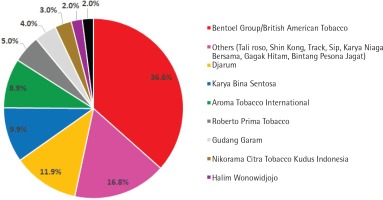INTRODUCTION
Tobacco control regulation in Indonesia is rudimentary, and Indonesia is the only Asian country that has not signed or ratified the WHO Framework Convention on Tobacco Control. Despite the government’s target to reduce adolescent smoking by 5.4% in 20191, the prevalence of adolescent smokers aged 10–18 years in Indonesia continues to increase, from 7.2% in 2013 to 8.8% in 2016, and 9.1% in 20181. A school-based survey reported that a staggering 78.5% of students in Indonesia had ever smoked cigarettes, of which 17.3% tried cigarettes for the first time at an age ≤13 years, and even 5% of male students at an age ≤7 years2.
Adolescent smokers have an increased risk of respiratory and non-respiratory diseases, nicotine addiction, and drug use3. The long-term impact is reinforced by the fact that most adolescents who smoke will continue to do so regularly throughout adulthood thus increasing the risk for chronic diseases4 including heart disease5, stroke6 and lung cancer7,8. Moreover, smoking behaviour in adolescence is also associated with other behaviour problems such as fighting and engaging in unprotected sex9, and substance abuse including alcohol, marijuana, and cocaine3,7,8.
A high density of cigarette outlets, high exposure to tobacco advertisements at point-of-sale, and open display of cigarette packs in outlets, stimulate tobacco use among adolescents10-13. Tobacco retailer density is significantly associated with the prevalence of ever smoking among students11 and higher odds of adolescent smoking initiation14. Moreover, the frequency of cigarette retailers passed on the way to school is a factor influencing lifetime smoking behaviour15. Other studies also reveal that the closer the distance to cigarette retailers, the higher the chance of smoking16, the lower the chance of quitting smoking17, and higher youth past-30-days smoking frequency18.
Tobacco advertisements placed in retailers near schools potentially trigger adolescent smoking behaviour. Tobacco advertising is very creative, appeals to youth19 and is associated with greater odds of smoking susceptibility20. A study in Germany identified an association between cigarette advertising exposure and having ever tried smoking in school children aged 10–17 years21. In Indonesia, 32.4% of high school students found that at least 1 in 15 cigarette advertisements shown to them encouraged them to smoke22. Systematic reviews and metaanalysis conclude that exposure to tobacco product displays at the point-of-sale increases both smoking and smoking susceptibility23,24.
Several regulations have been issued in Indonesia in an effort to curb smoking among adolescents. The government issued Government Act No 109/2012 prohibiting tobacco sales to children under the age of 18 years, and restricting the design and placement of outdoor tobacco advertisements25. The Indonesian Ministry of Education issued the Decree 64/2015 ruling schools as non-tobacco areas26, prohibiting smoking, tobacco sales and advertising in schools. At the local level, Banyuwangi regent passed Regulation No. 32/2016 prohibiting the placement of advertisements less than 25 m from schools27. However, these regulations do not protect children when they walk outside schools. Other than the prohibition of sales to minors, which is very weakly enforced, there is currently no other regulation controlling cigarette retailers and advertisement placement by retailers. Thus, cigarette retailers with and without advertisements are omnipresent and unregulated. Coupled with the cheap price of cigarettes in Indonesia, the lack of efforts to control cigarette retailers and point-of-sale advertisement near schools means that Indonesian adolescents can easily be drawn to purchase cigarettes near their schools.
There is a scarcity of evidence from Indonesia showing the density of tobacco retailers and points-ofsale. There is only one study conducted in Denpasar, Bali, which found 96.8% of schools have a point-ofsale within a 250 m radius28. More studies are needed to provide evidence to support a policy to control cigarette sales to adolescents. Therefore, this study aims to calculate the density of cigarette retailers near schools and the prevalence of factors associated with sales to minors in Banyuwangi, Indonesia. In line with the Indonesian requirements, permits for the study were granted by the local government, while the Ethics Committee of the Faculty of Public Health of Universitas Airlangga approved the study.
METHODS
Study design
In 2017 we evaluated Banyuwangi Regent’s Regulation on tobacco advertising ban in the district. Banyuwangi is located in East Java province, the largest tobacco-producing province in Indonesia, and has received many awards for its program and policy innovation, including the health sectors. The evaluation study was conducted on 13 roads and two non road locations where tobacco advertising has been banned in the Banyuwangi subdistrict of Banyuwangi, Indonesia27. We expect that if the government of Banyuwangi District is to regulate cigarette retailers, it would come into effect first in these locations. We conducted a geographical mapping of outdoor tobacco advertisement and cigarette retailers in these locations and interviewed owners/keepers of randomly selected retailers from the mapping between November and December 2017. Results of the tobacco advertisement assessment have been previously published29. The current study only analysed cigarette retailers. The study was conducted in two phases: Geographical (Geographical Information System – GIS) mapping and a survey of retail owners/keepers.
Phase 1: Geographical mapping
Sampling
To calculate the number of tobacco retailers in the study locations, all types of retailers in the study sites and their GPS locations were recorded. Retailers were defined as stores selling any consumer goods. We observed and recorded outdoor tobacco advertisements placed on retailer shops that were visible from the street and tobacco packs that were clearly displayed. Retailers were categorized as selling cigarettes when tobacco packs were clearly displayed. Outdoor advertisement was defined as all types of tobacco advertisement placed in the vicinity of the retailer shops and clearly visible from the street. We also collected GPS locations of all schools at the study locations, which were defined as formal schools from elementary to high school level. Data from Phase 1 were used as a sampling frame for Phase 2.
Data collection
Five teams of two trained enumerators collected the data using KoboCollect, an Android-based data collection application30, which is a part of KoBo Toolbox, a free and open source online data entry tool31. After training, all enumerators went through a field test period where their mapping and interview skills were assessed, and the data collection online forms were checked and revised as necessary. Acceptable GPS precision was set to less than 10 m. Quality control officers went to 10% of the data points collected by enumerators to check for errors or missing points.
Data Analysis
Descriptive analysis was used to assess the density of cigarette retailers and their proximity to schools. We used STATA 14 to calculate the number of retailers with and without outdoor advertisement. Using Quantum GIS 2.8.1, we calculated the proximity of the cigarette retailers to the nearest school using their GPS locations and categorized distance from schools as <25 m, 25–100 m, 100.1–250 m, 250.1–500 m, and >500 m. The 25 m cut-off was used to evaluate the distance where outdoor tobacco advertisement were prohibited by Banyuwangi Regents’ regulation29 while distances of 100, 250 and 500 m were used to facilitate comparisons with other studies conducted in Indonesia and several countries in Asia28,32,33.
The density of cigarette retailers was indicated by the number of cigarette retailers per 100 m of road length, while for the sports stadium or the city park the density of cigarette retailers was indicated by the number of retailers per 100 m length of all the streets within and surrounding the area. We also calculated the density of retailers in the school complex. The school complex was an area where a collection of schools (elementary, middle, and high school) were located close to one another. We also counted the number of cigarette retailers among all retailers and the number of cigarette retailers featuring outdoor tobacco advertisements.
Phase 2: Survey of retail owners/keepers
Sampling
We randomly selected for interview 150 of 180 consumer goods stores featuring outdoor tobacco advertisement29 using a random selection command in Stata V.14. By selecting a sample from stores featuring outdoor tobacco advertisement instead of those observed with cigarette packs on display, we hoped to include more cigarette retailers that might be concealing their cigarettes. Of the 114 storeowners/storekeepers that consented to an interview (3 stores had the same owners/keepers, 14 stores were closed at the time of the visit, and 19 owners/ keepers declined to take part in an interview), 107 sold cigarettes and thus their data were used in the analysis. With this sample size we covered 49.5% of all tobacco retailers in the study location.
Data collection
Enumerators visited the randomly selected retailers and explained the survey to the owners or keepers. After consenting, respondents were asked about the cheapest cigarette brands and selling price, the brand most purchased by adolescents, whether they ever refused any adolescents who attempted to purchase cigarettes in their stores, and their knowledge about government regulation prohibit selling cigarettes to people aged <18 years. Data were collected by ten enumerators using Android-based data collection apps on a mobile device30. The average interview time was 22 minutes for each respondent. Respondents who were not available for interview immediately after the consenting process were interviewed later at a more convenient time to the respondents. Another visit took place by a quality control team to 10% randomly-selected interviewed respondents for quality control.
Data analysis
Descriptive statistics (frequencies and percentages) were computed using Stata V.14. The cheapest cigarette price was categorized as <US$0.7 or ≥US$0.7 per pack, based on the median of data. We conducted a chi-squared analysis of the association between the lowest cigarette price and knowledge about a regulation banning sales to minors and retailers’ refusal to sell cigarettes to adolescents.
RESULTS
Phase 1: Geographical mapping
We identified 770 consumer goods retailers in the study location, of which 28.1% (216) sold cigarettes. Only one street in the 15 locations was free of cigarette retailers (Table 1). The overall mean density of cigarette retailers in 15 locations was 1.1 retailers per 100 m. The location with the highest cigarette retailer density (2.2 retailers/100 m) was on the main road (Jalan R. Wijaya). The density in the city park was 1.6 retailers/100 m, while in the sports stadium it was 0.8 retailers/100 m (Table 1).
Table 1
Number and percentage of schools, cigarette retailers, and density, Banyuwangi, East Java, Indonesia, 2017
There were 31 schools in the study locations. Using their GPS locations, we found that 6.9% of the 216 cigarette retailers were located <25 m from schools, and most of the retailers (27.8%) were located at a distance of 100.1–250 m from schools. The closest cigarette retailers from a school were only 1.7 m away. We found that 9 (29.0%) of the 31 schools in the study sites had at least one cigarette retailer within 25 m, 25 (80.6%) schools within 100 m, and all schools had at least one cigarette retailer within a 250 m radius (Figure 1).
Figure 1
Density and proximity of cigarette retailers near schools in Banyuwangi, East Java, Indonesia

In all, 73.1% of the retailers featured outdoor tobacco advertisements. Of retailers located <25 m, 66.7% had outdoor tobacco advertisements placed in their stores, which was less than those located farther from schools (Table 2). The most prevalent types of advertisements near schools were posters and banners, but banners were more prevalent within <25 m (Table 2).
Table 2
Number and percentage of cigarette retailers with outdoor tobacco advertisement (n=158 ) and advertisement type (n=158) by distance from the nearest schools, Banyuwangi, East Java, Indonesia, 2017
Phase 2: Survey of retail owners/keepers
Of the 107 interviewed cigarette retail owners/keepers, 101 provided information on the cheapest cigarette price they sold, 94 provided information on refusal to sell cigarettes to adolescents, 92 provided information on the popular cigarette brand among adolescent, 101 provided information on the cheapest cigarette brand, and 107 provided information on knowledge of the regulation prohibiting cigarette sales to minors.
The cheapest cigarette price sold ranged from US$0.4 to US$1.5 per pack (exchange rate: US$ 1 = IDR 14080). Of all cigarette retailers, 48.0% sold the cheapest pack of cigarettes at <US$0.7. We found that 43.6% of the respondents stated that they had at least once refused to sell cigarettes to adolescents. When we categorized those selling the cheapest pack of cigarettes at <US$0.7 per pack versus ≥US$0.7 per pack, 56.1% of cigarette retailers selling at the lowest price of <US$0.7 per pack reported to have had refused once to sell cigarettes to adolescents, while only 43.9% of cigarette retailers with the lowest price of ≥US$0.7 per pack had ever refused to sell cigarettes to adolescents. However, the difference was not statistically significant (p=0.39). In the school complex, 90.0% of retailers had once refused to sell cigarettes to minors. This number was higher than that at the sports stadium where only 20.0% of retailers had ever refused adolescents attempting to purchase cigarettes. There were only 38 (35.5%) of cigarette retailer owners/keepers who knew about the regulation prohibiting cigarette sales to minors. There was no significant association between retailers’ refusal to sell cigarettes to adolescents and their knowledge about the regulation that prohibited cigarette sales to minors (p=0.07).
The most popular cigarettes among children were from Gudang Garam (54.4%), which included brands such as Surya (50.0%), Gudang Garam (3.3%), and Pro-Mild (1.1%). The second most popular cigarettes were from HM Sampoerna/Philip Morris International (27.2%) (Figure 2). The cheapest cigarettes sold were from Bentoel Group/British American Tobacco (36.6%), which included brands such as Tali Jagat (28.7%), Lucky Strike (6.9%), and Dunhill (1.0%) (Figure 3). The cheapest cigarette was Tali Jagat, which was sold for 0.4–0.9 US$ per pack.
DISCUSSION
Main findings
Our study shows that the mean density of cigarette retailers in Banyuwangi was 1.1 retailers per 100 m (range: 0.4–2.2 per 100 m). Most of the retailers (27.8%) were located at a distance of 100.1–250 m from schools and had outdoor tobacco advertisements (73.1%). Of all retailers, only 43.6% had once refused to sell cigarettes to adolescents. The most popular cigarettes for adolescents were of Gudang Garam Brands (50.0%), and the cheapest cigarettes were from Bentoel Group, which is a part of British American Tobacco (36.6%). The cheapest brand was Tali Jagat, which was sold at 0.4–0.9 US$ per pack.
All of the schools in our studies had neighbouring tobacco retailers within 250 m, which was higher than that reported in Bali, Indonesia, where 96.8% of schools had a tobacco retailer within a 250 m radius28. The nearest cigarette retailers to schools in this study (1.7 m) were also closer than reported for Bali (2.9 m)28.
We have previously reported that 23.4% of all types of retailers placed outdoor tobacco advertisements on their stores29. The current study shows that a much higher percentage (73.1%) of cigarette retailers featured outdoor tobacco advertisements. Comparing our results on outdoor tobacco advertisement with that from other countries is difficult as there are currently not many other countries that allow outdoor tobacco advertisements.
The price of cigarettes in our study was lower than that in Malaysia, which sets the lowest price of cigarettes at US$1.734. Our finding is in line with the fact that Indonesia occupies the 9th position of 88 countries with the lowest cigarette prices globally and is 6th out of 29 Asian countries with the lowest cigarette prices35.
The high density of cigarette retailers in the study location was not surprising as there were very limited regulations governing cigarette retailers and tobacco sales to minors in Indonesia. The high refusals of purchase attempts in the school complex may indicate higher compliance to the regulation banning tobacco sales to people aged <18 years. However, our results show that retailers’ knowledge of the regulation was not associated with selling tobacco to minors. This indicates that the refusal number perhaps was more of a reflection of adolescents’ attempt to purchase cigarettes near their schools.
Although there were violations to the advertisement ban within 25 m of schools, the lower percentage of retailers posting tobacco advertisement <25 m from schools compared to retailers located ≥25 m might indicate some positive results from the implementation of the ban. Nevertheless, the number of violations still indicates weak enforcement of the regulation.
This study also found that cigarettes were sold at very affordable prices (0.4–1.5 US$ per pack). This price is much lower than the pocket money of many Indonesian children, reported to be on average US$39.1 per month or around US$1.3 per day36. Our study found that Surya from Gudang Garam was the most popular brand among adolescents. This particular brand has a variety of packaging, including a can of 50 cigarette sticks, which can be sold individually. This allows adolescents to purchase a cigarette at a fraction of the cost of a pack. Also, it might not be a coincidence that Gudang Garam was also the company with the highest shares of outdoor tobacco advertisement29. The combination of the high density of retailers close to schools, the high number of tobacco retailers featuring outdoor tobacco advertisements, the affordable price and the single stick sales, if maintained, will continue to increase the smoking prevalence among adolescents in Indonesia.
Policy implications
Although the Indonesian Ministry of Education has ruled out cigarette sales in schools as part of the no-smoking area regulation, adolescents can attempt to purchase cigarettes outside of their schools. The availability of cigarette retailers near schools and even <25 m from schools facilitates adolescents to initiate smoking. Although there were violations to the advertisement ban within 25 m of schools, the lower number of retailers placing outdoor tobacco advertisements within 25 m of schools in Banyuwangi shows that the regulation is a potentially effective measure. This means that the total ban on outdoor tobacco advertisement should be pursued in this District.
This study and the study in Bali show that the Indonesian government needs to regulate tobacco sales by establishing zones where tobacco sales are permitted. Ban of tobacco sales within 100 yards (91.44 m) of educational institutions has been shown to reduce retailer density in India37. The study in Bali suggests prohibiting sales within a 500 m radius may deliver the greatest impact and the adoption of tobacco retailer ban within at least 100 m radius from schools will likely reduce youth exposure to cigarette marketing28. As many adolescents attempt to purchase, regulation for cigarette trader licensing is also worth considering. The licensing can enforce the prohibition of sales to minors as licensed retailers will be required to ask for identity cards for proof of age and must refuse to sell cigarettes to those who cannot show their identity card28,38. All these regulations, however, will not be effective without proper surveillance and heavy penalties. A study reported that high surveillance and heavy penalties for violation are an important aspect to ensure reduction in smoking among adolescents14. It has been shown in Taiwan that a heavy penalty for selling to minors deters cigarette retailers from sales to minors28,38. Tobacco control regulation in Indonesia is rudimentary but even the currently available regulation does not constitute a strong measure against violations and the surveillance system to detect violations needs upgrading29. Retailer zones can be easily implemented in Banyuwangi, as this District has previously successfully placed a moratorium for franchised mini-markets to protect small scale businesses. Although most cigarette retailers in the District are small scale businesses, the District’s focus on ecotourism development29 can be a means to stimulate small scale business to sell items that are more in line with ecotourism.
The government of Indonesia still allows the use of terms that may insinuate a safer cigarette product such as ‘light’ and ‘mild’ as part of cigarette brand names. Cigarette with flavours that are appealing to adolescents such as fruits and mints, have recently become more popular. Our study, however, did not assess such word descriptors in the cigarette brands. Therefore, further study should include these types of cigarettes to provide evidence for policy change.
Strengths and limitations
This is the second paper illustrating the density of cigarette retailers in Indonesia and the first conducted in Java, the most populous island in the country. This study was carried out only on main roads where the advertisement ban was already effective; thus, our results might be an underestimation of the actual cigarette retailer density. We assessed advertisements on retailers that were visible from the street instead of the total advertisement inside the stores. Our estimates for advertisement, therefore, are an underestimation of the total efforts of the tobacco industry to persuade purchase through advertisement at point-of-sale. We also did not assess the actual frequency of purchase either in packs or single sticks by adolescents and thus could not provide more detailed information on their purchasing behaviour.
CONCLUSIONS
Cigarette vendors surround schools in Banyuwangi. Most of the cigarette retailers posted outdoor tobacco advertisements and sold cigarettes at a price affordable by adolescents. All of these may attract adolescents to initiate smoking. There need to be regulations such as zoning and licensing to control cigarette sales to minors.




